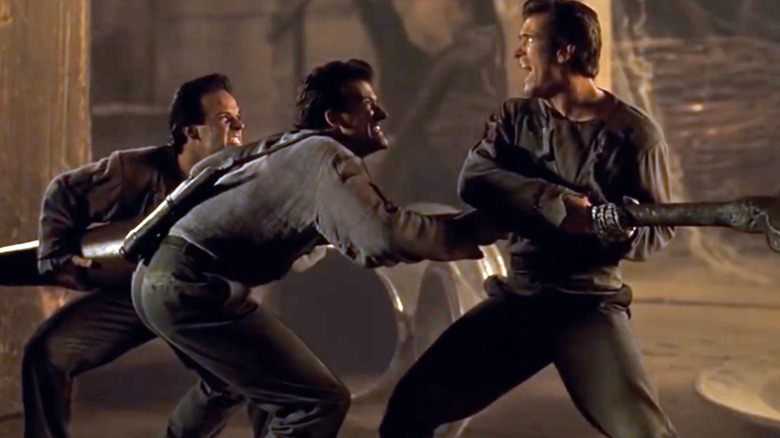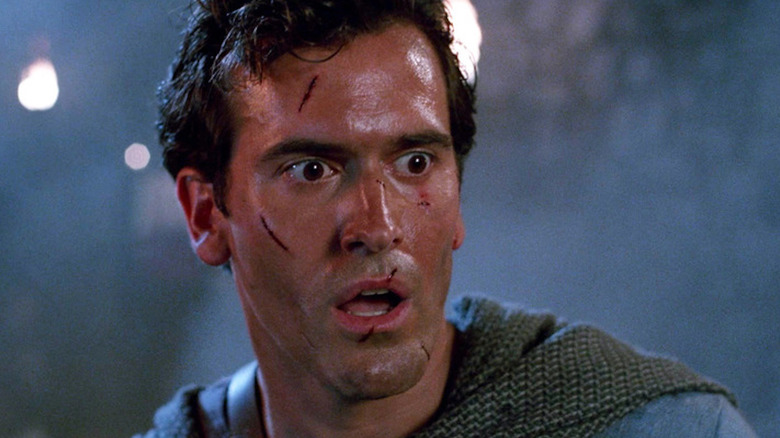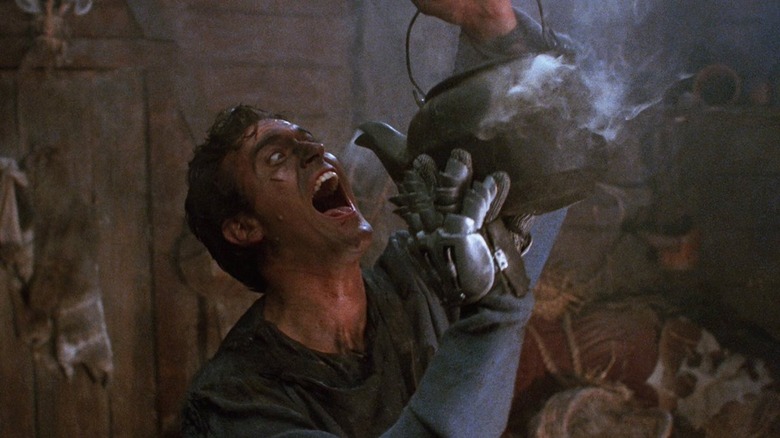This Is How They Created The Mini-Ashes For Army Of Darkness
In the early 1990s, Sam Raimi was a low-budget horror maestro who'd made the leap to studio filmmaking without sacrificing his gonzo visual style. Riding high off the commercial success of 1990's "Darkman," a deliriously fun and funky comic-book riff that still stands as one of the best superhero movies ever made, Raimi could pretty much call his shot. So he did. And that's how Universal Pictures bankrolled the third installment of a horror series that most people had never heard of, let alone seen.
The ending of "Evil Dead 2," which dropped the modern-day hero of the first two, tenuously linked movies, in the Middle Ages was an unexpected howler of a punchline. Under no circumstances did I expect Raimi would actually make a third movie set in medieval times. That would be expensive. And silly. But if you could suddenly afford to make an expensively silly movie, would you not?
Raimi plunged forward and made "Army of Darkness," a slightly more audience-friendly (i.e. less gory) chapter of his "Evil Dead" franchise. This was a series that only existed because Raimi convinced his friends and family to kick in cash for what Joe Bob Briggs would eventually call a "spam in a cabin" flick. Now he had a budget of $11 million to bring his accidental horror trilogy to a close. Ironically, it wasn't quite enough to comfortably realize the more complicated visual effects his script called for. So he had to experiment.
Ash versus Ashes
Fans of Raimi's early work could stomach his movies' ramshackle construction, but how would this fly in a studio film? Evidently, no one at Universal asked that question. "Army of Darkness" looks like a Cannon flick. You can see the seams, and sense the behind-the-scenes scramble. "How are we ever going to pull this off?" Certain VFX-heavy sequences appear to have been shot on the fly. One such set piece is the moment where Bruce Campbell's Ash finds himself battling mischievous mini versions of himself.
According to the commentary track for the 95-minute director's cut version of "Army of Darkness," this scene was spearheaded by Introvision's William Mesa. It's a pre-CG bit of optical trial-and-error, one that required doubles and the manipulation of perspective. Per Campbell:
"We had, I don't know how many of these guys, in total. Six or seven. But for specific shots there were three of us. There was myself and two other guys, Bruce Thomas and Deke Anderson, who were sort of lookalikes for me. And what we did was, we had them wear Bruce Campbell chins and Bruce Campbell noses, and several of these guys, once you've got 'em all tricked up, they wound up being pretty good doubles. Because they were so small on screen, it was harder to tell the details."
An innovative madman
Per the commentary, pulling these scenes off required an audible counting off of seconds so the Introvision crew could sync up Campbell's actions with his doubles' performances. This process became more complicated when they had to bring in a giant fork, which gets poked into Campbell's backside. The finished product is far from seamless, but it's in keeping with Raimi's handmade aesthetic. You don't care how it looks. You just care that it's funny.
"Army of Darkness" was quickly swept out of theaters in 1993, and Raimi fought hard to redefine himself via "The Quick and the Dead," "A Simple Plan" and "For Love of the Game." These are all fine movies (and, seriously, the baseball movie is terrific), but it took "Spider-Man" for the industry to fully embrace Raimi. Now, 20 years later, he's one of the few A-list blockbuster filmmakers who, CG be damned, wants his movies to have a tangible quality. He's still tapping into the inventive madman who launched his career via stop-motion gore. We need more Raimis.


